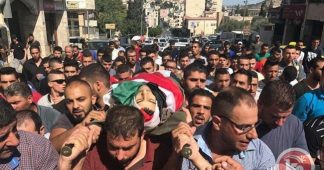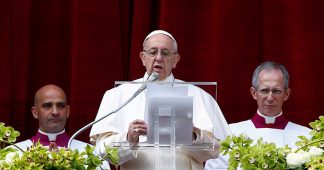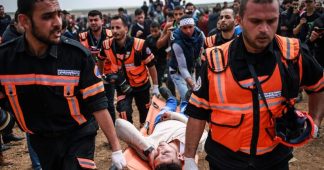More than 1,400 have been wounded in clashes between Palestinian protesters and the Israeli military. The media has barely noticed.
By
April 6, 2018
Gaza is back in the headlines, grabbing, if only for a moment, the fickle international spotlight. The two million Palestinians living in the 141-square-mile spit that hugs the Mediterranean have no such luxury. They cannot escape the misery, manufactured by powers greater than themselves, that has been Gaza’s fate for much of the last generation.
Gaza today is a prison, bound to its north by Israel and its south and east by Egypt, both of which for their own reasons are conspiring to continue its penury and isolation. To the west lies the Mediterranean, deceptively open but just as impenetrable. In a faraway time Gaza was once an entrepot—a thriving seaport on the Mediterranean linking the west with the Arab heartland to the east. Its location along the hotly contested Mediterranean coast, where an abundance of natural gas has recently been discovered, is a cruel reminder of what Gaza—which the World Bank warns will be uninhabitable by 2020 if current policies continue—could be.
In recent days 17 Palestinians have been shot and killed by Israeli forces positioned along the 32-mile fortified border separating Israel from the impoverished enclave. An extraordinary 1,416 have been wounded in clashes between Palestinian protesters and the military, including 750 injured by live fire.
The UN Security Council was poised to approve a statement expressing “grave concern at the situation at the border,” reaffirming “the right to peaceful protest” and expressing the Council’s “sorrow at the loss of innocent Palestinian lives.” The draft called “for respect for international human rights law and international humanitarian law, including protection of civilians.” Council members “called upon all sides to exercise restraint and prevent a further escalation,” and endorsed an “independent and transparent investigation” of the confrontations. The U.S. then blocked the approval of the statement.
“As for a commission of inquiry—there won’t be one,” Minister of Security Avigdor Lieberman flatly stated to Israel Army Radio.” Israeli soldiers did what was necessary. I think all our soldiers deserve a medal.”
The scale of the violence, not seen since the war between Israel and Gaza in 2014, even muscled its way into the Pope’s Easter address, which called for “reconciliation for the Holy Land, also experiencing in these days the wounds of ongoing conflict that do not spare the defenseless.”
The confrontations were the opening volley in planned Palestinian protests that are meant to culminate on May 15 in a massive nonviolent march by Gazans, more than two thirds of whom are refugees or their descendants, across the tense border to Israel.
Those demonstrating opposite Israeli troops are the grandchildren of the refugees memorialized in 1957 by then-chief of staff Moshe Dayan as “a surging sea of hatred and vengeance, yearning for the day that the tranquility blunts our alertness…. Why should we complain of their hatred for us? Eight years have they sat in the refugee camps of Gaza, and seen, with their own eyes, how we have made a homeland of the soil and the villages where they and their forebears once dwelt.”
A decade later, Dayan, as minister of security, made the momentous decision to remove the border fences, erasing the border that separated the Palestinians living in the just-conquered Gaza Strip and West Bank from Israel. In 1982, Security Minister Ariel Sharon ordered the removal of the two conscripts manning a portable checkpoint that marked the all-but-invisible border between Israel and Gaza. For a generation, Palestinians traveled all but unhindered across the old border, providing grist for the myth of Israel’s “benevolent occupation.” That all came crashing down in the waning days of 1987, when a traffic accident in Gaza sparked the first intifada (uprising) against Israel.
Thus began decades of restrictions on Palestinian movement that have found their most destructive expression in the permanent siege of Gaza.
Prime Minister Ariel Sharon startled many when he ordered the removal of all settlements and troops from Gaza in September 2005, not least PLO chairman Mahmoud Abbas, who never believed until Israeli forces locked the gate at the Karni crossing that Sharon would make good on his promise.
Abbas and most everyone else did not understand that Sharon was not leaving Gaza. He was unilaterally redefining Israel’s relationship with it. Israel, notwithstanding its historic 1993 deal with the PLO, remained an occupying power constrained by its international obligations to safeguard the welfare of the local population. After the Gaza disengagement, Israel unilaterally redefined Gaza as enemy territory, where the rules of war, rather than the obligations of occupation, apply. But for Israel’s retreat, the draconian restrictions on Palestinian movement, production, and commerce, the continuing “siege” on Gazans heartlessly described as a “diet” by a Sharon confidante, would have been all but impossible.
For Israel in this new era, the border with Gaza has become sacrosanct, both as a symbol and as an instrument of Israeli sovereignty—to be defended, as we have seen, without mercy for the refugees pressing against the barbed wire. Palestinians may have no use for a border that constrains them and confers upon them nothing but misery and the bitter memory of their personal and national defeat. The international community is exhausted and bored with the conflict. Even when the Trump White House has an idea—the latest being a conference on humanitarian aid for Gaza—it has no enthusiasm for its success. In the absence of any consensual diplomatic process that can offer an alternative, moderating narrative, the “March of Return”—set to culminate on May 15—and Israel’s ferocious defense of the border, will prevail.
Geoffrey Aronson is chairman and co-founder of The Mortons Group and a non-resident scholar at the Middle East Institute.
Published at http://www.theamericanconservative.com/articles/violence-in-gaza-today-captures-the-attention-of-no-one/











